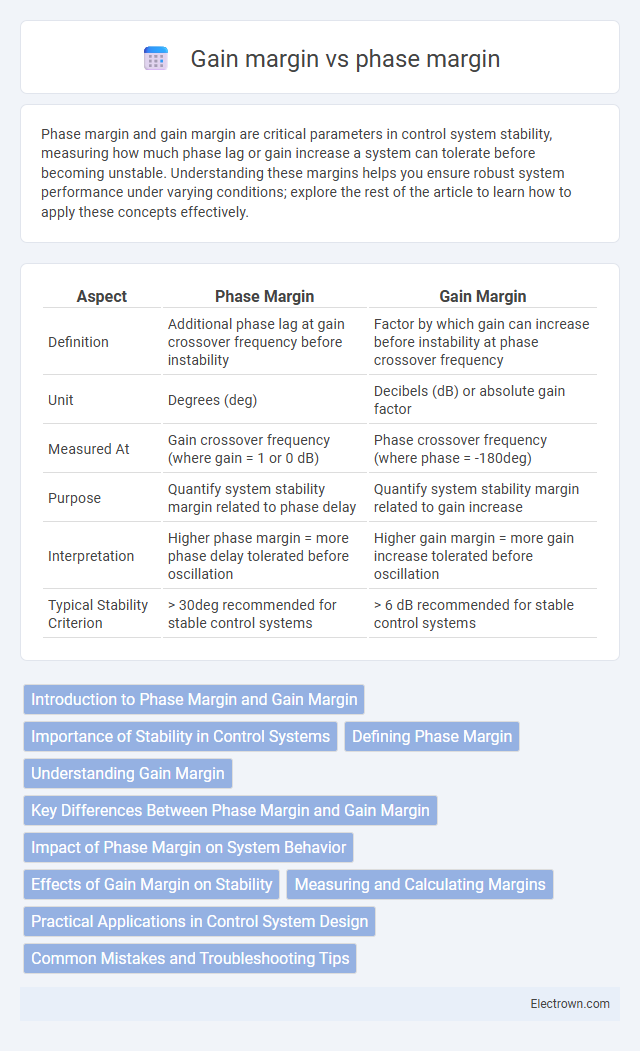Phase margin and gain margin are critical parameters in control system stability, measuring how much phase lag or gain increase a system can tolerate before becoming unstable. Understanding these margins helps you ensure robust system performance under varying conditions; explore the rest of the article to learn how to apply these concepts effectively.
Table of Comparison
| Aspect | Phase Margin | Gain Margin |
|---|---|---|
| Definition | Additional phase lag at gain crossover frequency before instability | Factor by which gain can increase before instability at phase crossover frequency |
| Unit | Degrees (deg) | Decibels (dB) or absolute gain factor |
| Measured At | Gain crossover frequency (where gain = 1 or 0 dB) | Phase crossover frequency (where phase = -180deg) |
| Purpose | Quantify system stability margin related to phase delay | Quantify system stability margin related to gain increase |
| Interpretation | Higher phase margin = more phase delay tolerated before oscillation | Higher gain margin = more gain increase tolerated before oscillation |
| Typical Stability Criterion | > 30deg recommended for stable control systems | > 6 dB recommended for stable control systems |
Introduction to Phase Margin and Gain Margin
Phase margin and gain margin are critical stability metrics in control systems, quantifying how close your system is to oscillation or instability. Phase margin measures the additional phase lag required to reach the critical -180 degrees at the gain crossover frequency, while gain margin indicates the factor by which the system gain can increase before reaching instability at the phase crossover frequency. Understanding these margins helps ensure robust performance and safe operation of feedback control loops.
Importance of Stability in Control Systems
Phase margin and gain margin are critical indicators of stability in control systems, ensuring the system remains responsive without oscillations or instability. A sufficient phase margin, typically above 30 degrees, provides a buffer against phase shifts that could lead to instability, while a gain margin greater than 6 dB protects against variations in system gain. Maintaining these margins is essential for reliable performance and safety in applications such as robotics, aerospace, and industrial automation.
Defining Phase Margin
Phase margin represents the difference in phase between the system's open-loop frequency response and -180 degrees at the gain crossover frequency, where the gain is unity (0 dB). It indicates the amount of additional phase lag required to bring the system to the verge of instability, providing insight into system stability and robustness. A higher phase margin typically implies greater tolerance to parameter variations and improved oscillation damping.
Understanding Gain Margin
Gain margin measures how much gain can increase before a system becomes unstable, providing a critical safety buffer in control systems. Unlike phase margin, which evaluates the system's tolerance to phase shifts, gain margin specifically quantifies the allowable gain increase at the phase crossover frequency. Understanding gain margin helps you ensure robust stability and avoid oscillations in feedback control loops.
Key Differences Between Phase Margin and Gain Margin
Phase margin measures the stability buffer by indicating how much the phase can change before the system becomes unstable, while gain margin quantifies how much gain increase the system can tolerate without losing stability. Phase margin is expressed in degrees and relates to the frequency where the gain crosses 0 dB, whereas gain margin is expressed in decibels and relates to the frequency where phase reaches -180 degrees. Understanding these key differences helps you design control systems with adequate robustness against oscillations and performance degradation.
Impact of Phase Margin on System Behavior
Phase margin directly influences system stability by indicating how close the system is to oscillation, with higher phase margins providing greater damping and reduced overshoot. It affects transient response characteristics such as settling time and peak overshoot, ensuring smoother control actions in feedback systems. A low phase margin often leads to increased sensitivity to parameter variations and potential instability, making it critical for robust control design.
Effects of Gain Margin on Stability
Gain margin directly impacts the stability of control systems by indicating how much gain can increase before the system becomes unstable, with a larger gain margin typically signaling better robustness to parameter variations. A negative or small gain margin often leads to reduced stability and increased risk of oscillations or system failure. Ensuring sufficient gain margin in your design helps maintain reliable performance even under varying operating conditions.
Measuring and Calculating Margins
Phase margin is measured by identifying the frequency at which the open-loop gain crosses 0 dB and calculating the difference between the phase at this frequency and -180 degrees. Gain margin is determined by locating the frequency where the phase crosses -180 degrees and measuring the difference between the gain at this point and 0 dB. Both margins are calculated using Bode plots, providing critical stability insights for control systems and amplifiers.
Practical Applications in Control System Design
Phase margin and gain margin are critical metrics in control system design, helping engineers ensure stability and robust performance under varying conditions. High phase margin indicates the system can tolerate significant phase shifts before becoming unstable, while gain margin measures the allowable increase in gain without loss of stability. Understanding these margins enables you to design controllers that maintain desired stability and responsiveness in real-world applications such as aerospace, robotics, and process control systems.
Common Mistakes and Troubleshooting Tips
Confusing phase margin with gain margin often leads to incorrect stability assessments in control systems. A frequent mistake is neglecting that phase margin measures how close the system is to oscillation at the gain crossover frequency, while gain margin indicates how much gain can increase before instability, requiring separate analysis of frequency response plots. Troubleshooting involves verifying Bode plot crossover points precisely and using simulation tools to confirm margins, ensuring controller tuning achieves both adequate phase and gain margins for robust system performance.
Phase margin vs gain margin Infographic

 electrown.com
electrown.com